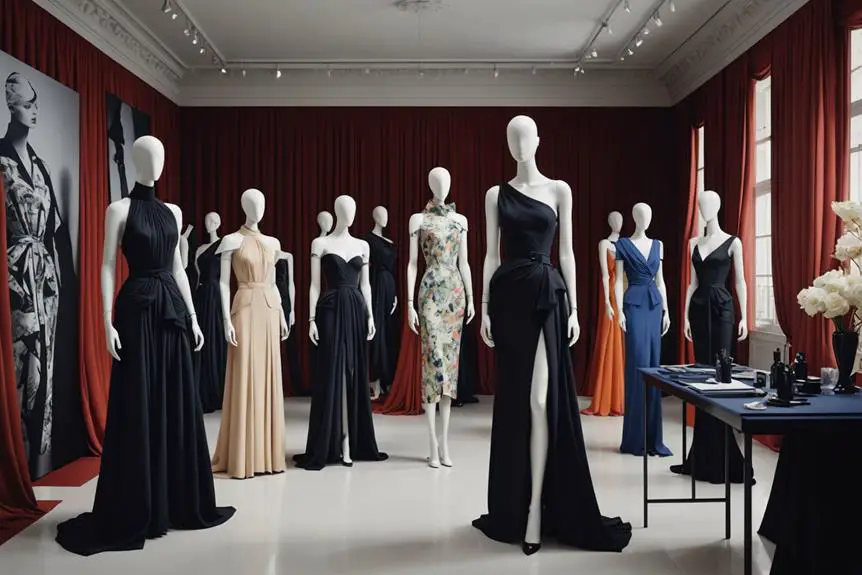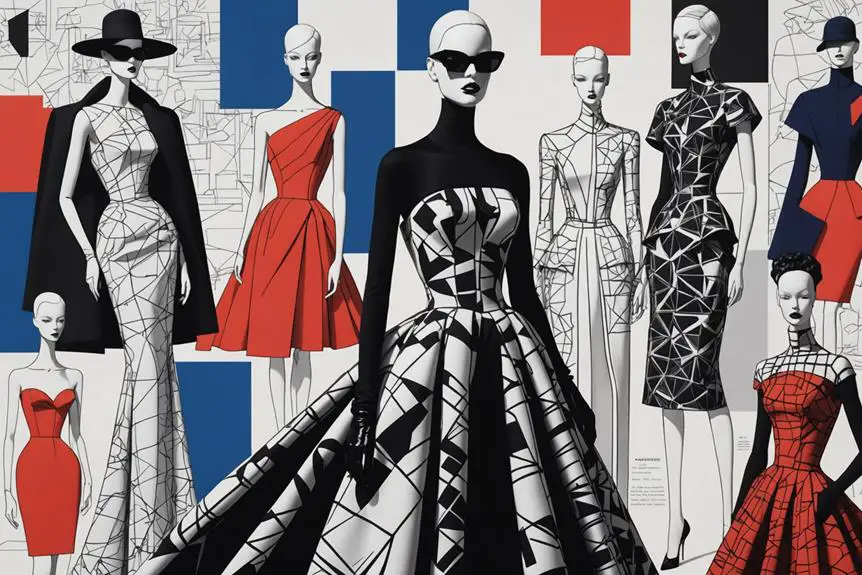When considering the evolution of women's fashion, Cristóbal Balenciaga's contributions stand out prominently. His unique approach to design not only reshaped silhouettes but also challenged the conventional norms of style in the 20th century. From his early days in Spain to his influential Parisian fashion house, Balenciaga's journey is marked by innovation and artistic integrity. What truly set him apart was his ability to blend structure with fluidity, creating garments that were both sculptural and wearable. His legacy continues to resonate in today's fashion landscape, influencing contemporary designers who draw inspiration from his pioneering techniques and visionary aesthetics.
Early Life and Background

Cristóbal Balenciaga was born into a world of contrasts on January 21, 1895, in Getaria, Spain, where his seamstress mother and fisherman father shaped his early experiences. Growing up in a small Spanish town, surrounded by the ocean and the emerging world of fashion, Balenciaga was immersed in creativity from a young age. At just 12 years old, he began his tailoring apprenticeship, laying the foundation for what would become an illustrious career in fashion.
By 1917, Balenciaga had opened his first fashion house, Eisa, and quickly expanded his reach with boutiques in Madrid and Barcelona. However, it was his move to Paris in 1937 that solidified his reputation as a fashion innovator. His unique designs garnered attention, aided by the early support of the Marchioness de Casa Torres, who recognized his talent before it was widely acknowledged.
Throughout his life, Balenciaga maintained a private personal life, identifying as gay and having a long-term partner. This aspect of his life infused his work with emotional depth, allowing him to create pieces that resonated profoundly with many. His early experiences in Getaria, combined with his personal relationships, played a pivotal role in shaping the innovative designs we admire today. Balenciaga's journey illustrates how our backgrounds influence our passions, reminding us that every stitch tells a story and that every designer has a unique path.
Career Journey and Achievements
Launching his career at just 12 years old, Cristóbal Balenciaga quickly made a name for himself in the fashion world. Starting as a tailor in San Sebastián, he founded his first fashion house, Eisa, in 1917. However, it was his move to Paris in 1937 that truly catapulted him into fame. The Spanish Civil War prompted his relocation to this fashion capital, and he soon became one of the most sought-after and exclusive couturiers. His first runway collection debuted that same year, and it was an immediate success!
Balenciaga was renowned for his innovative designs that transformed the fashion landscape. He introduced groundbreaking styles such as the sack dress and the baby doll dress, which challenged the traditional silhouettes that women had grown accustomed to. Imagine stepping into a room wearing something so avant-garde; he made that a reality for many. His clientele included iconic figures like Ava Gardner and the Duchess of Windsor, who were left heartbroken when his fashion house closed in 1968.
Yet, Cristóbal Balenciaga's legacy continues to resonate in the fashion industry today. Esteemed designers such as Hubert de Givenchy and Emanuel Ungaro cite him as a significant source of inspiration. So, the next time you admire a chic outfit, remember the visionary behind it. Balenciaga didn't just create clothing; he redefined the very essence of fashion! Isn't that remarkable?
Design Innovations and Techniques

Balenciaga's impact on fashion transcends his celebrity clientele and iconic collections; it's deeply embedded in his groundbreaking design innovations and techniques. Cristóbal Balenciaga was a true pioneer, renowned for his innovative pattern cutting and draping that produced sculptural silhouettes unlike any other. His designs frequently deviated from traditional fashion norms, ushering in a new era of liberated silhouettes that celebrated the natural form of the body. Can you envision a fashion world where the waistline was more of a suggestion than a rule? That's precisely what he achieved with the sack dress in 1957, offering women a relaxed, stylish fit that revolutionized the industry.
His passion for luxurious materials, particularly silk gazar, made his designs radiate with bold shapes and unique textures. Imagine an evening dress that flows elegantly, catching the light in mesmerizing ways. The texture and feel of his garments were just as vital as the design itself. Balenciaga's enchanting construction techniques enabled him to create stunning pieces like the balloon jacket and the four-pointed envelope dress, seamlessly merging architectural forms with fashion. This innovative approach echoes his legacy of avant-garde concepts, which continues to inspire modern designers and push the boundaries of contemporary fashion.
What's even more intriguing is his methodology in garment creation. Rather than sketching, he would immerse himself in the fabric, allowing it to guide his inspiration. Doesn't that sound like an exhilarating creative journey? Balenciaga didn't merely design clothes; he crafted wearable art that transformed our perception of fashion today. So, the next time you admire a beautifully crafted dress, consider the genius and artistry behind its creation!
Legacy and Cultural Impact
Since his groundbreaking work in the mid-20th century, Cristóbal Balenciaga has left an indelible mark on the fashion landscape, shaping not just haute couture but also the broader cultural narrative around style. Balenciaga's innovative designs and techniques redefined women's fashion, setting a new standard that continues to resonate today. The influence of his iconic designs is felt across numerous fashion houses, each drawing inspiration from his visionary approach.
His legacy shines bright, especially with the relaunch of the Balenciaga brand in 1986. The brand has expertly preserved his original design philosophy while seamlessly integrating it into modern collections, demonstrating a remarkable ability to stay relevant in the ever-evolving fashion industry. The Cristóbal Balenciaga Museum in Getaria serves as a testament to his impact, showcasing over 1,200 pieces in a veritable treasure trove of couture history.
Balenciaga's influence extends beyond fashion. His work has inspired countless exhibitions and academic studies, securing the cultural recognition he rightfully deserves. His pioneering techniques and unique silhouettes are evident in the designs of contemporary creators like Nicolas Ghesquière and Demna Gvasalia, who continue to honor his legacy by infusing their work with his revolutionary spirit.
Continued Influence in Fashion

Continuing to shape the fashion landscape, Cristóbal Balenciaga's innovative techniques remain a gold standard for contemporary designers. His unique pattern cutting and draping have inspired countless fashion creators, setting the bar high for craftsmanship in haute couture. Can you imagine the impact of his pioneering silhouettes like the sack dress or the baby doll dress? They've not only influenced styles but also contributed to trends like the mini-dress in the 1960s.
The Balenciaga brand, relaunched in 1986, showcases a mix of Balenciaga's original designs and modern innovation. It's fascinating how past and present can blend so seamlessly, right? Notable contemporary designers such as Nicolas Ghesquière and Demna Gvasalia have cited Balenciaga's work as foundational. His influence is everywhere!
Here's a quick look at what makes Balenciaga's designs stand out:
| Feature | Description | Impact |
|---|---|---|
| Innovative Techniques | Unique pattern cutting and draping | Sets benchmarks in haute couture |
| Pioneering Silhouettes | Sack dress and baby doll dress | Influences trends like the mini-dress |
| Enduring Legacy | Exhibitions at places like the V&A Museum | Inspires future generations of designers |
Exhibitions featuring Balenciaga's garments highlight his enduring legacy. They remind us of the craftsmanship that transcends time. So, next time you admire a modern outfit, think about how Cristóbal Balenciaga paved the way for today's fashion. Isn't that amazing?
Frequently Asked Questions
What Style Is Cristóbal Balenciaga Known For?
Cristóbal Balenciaga's style is characterized by avant-garde silhouettes and innovative tailoring. His sculptural designs highlight dramatic proportions, minimalist aesthetics, and architectural influences, emphasizing feminine empowerment through fabric experimentation and striking color contrasts, resulting in timeless elegance.
Who Is the Main Designer at Balenciaga?
You'll find that the main designer at Balenciaga, Demna Gvasalia, skillfully merges the brand's rich heritage with contemporary interpretations. His visionary design philosophy emphasizes fabric innovation and striking runway aesthetics, playing a significant role in shaping today's fashion influence and cultural impact.
What Did Coco Chanel Say About Balenciaga?
Chanel's admiration for Balenciaga stemmed from their fashion rivalry. She acknowledged his design influence, often sharing personal anecdotes about his remarkable creativity. Their style comparisons revealed a mutual respect that highlighted his lasting impact on the industry, particularly through his iconic collaborations.
What Ethnicity Is Cristóbal Balenciaga?
Cristóbal Balenciaga's ethnicity is Spanish, with deep roots in Basque heritage. His cultural identity and family background significantly shaped his fashion legacy, reflecting regional traditions and artistic influences that informed his innovative design philosophy throughout his upbringing. Balenciaga's work is a testament to the rich cultural tapestry of his origins, which he masterfully integrated into his iconic designs.




Hi mates, good article and good arguments commented
at this place, I am actually enjoying by these.
Your article helped me a lot, is there any more related content? Thanks!